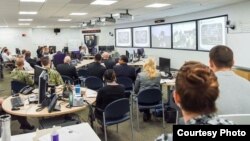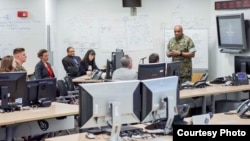In the controlled environment of the United States military, the big room with shiny white paint stands out.
The room has computer work stations, overhead projectors and a digital clock that shows the current time in cities around the world.
But what captures the attention of many visitors are the walls. They are covered from top to bottom with questions, mathematical notations, pictures and ideas. These markings represent the best thinking of some of the greatest minds in the military.
"There are precious few places in this building where you can write on a wall," said Albert Bolden. His claim is not too surprising since this area, the Innovation Hub or iHUB, is part of a military base.
Bolden is director of innovation at the U.S. Defense Intelligence Agency (DIA).
"People from across the agency can come into this space and figure out how to solve our problems," he said.
'Relevant in this digital age'
This might seem like a feel-good story of military structure mixing with Silicon Valley creativity to make life easier with technology. But it is about much more.
Marine Lieutenant General Vincent Stewart has served as the DIA’s director. He said, “The fight for remaining relevant in this digital age is what keeps me awake."
Stewart made clear that it is, in many ways, an arms race.
"Our adversaries have been modernizing," he warned, speaking to a small group of reporters and others at the iHUB in August. The agency had invited business representatives and academic experts there for a series of what were called Industry Days.
Such meetings between top thinkers at the DIA and those outside of government are an important part of iHUB’s planning. U.S. officials want to know if commercial technologies could help solve problems that agency experts have identified.
One company seeking to be part of this effort is a Texas-based start-up business called SparkCognition. It specializes in artificial intelligence: making computers perform work that normally requires human intelligence.
The U.S. Air Forces has already shown an interest in SparkCognition. Also, large companies like Verizon and Boeing are now investing more than $30 million in the small start-up's neural network effort. It is designed to copy the operations of a human brain in order to predict results.
"What we've done is automate that research that a data scientist would do," said SparkCognition's Sam Septembre.
Instead of taking weeks or days, however, Septembre said his company's systems can provide results in hours or even minutes.
SparkCognition says its platforms already have succeeded in predicting some major world events, although the test cases still leave room for improvement.
"The human factor got involved and skewed it," said Timothy Stefanick, director of business operations at the company. He explained that some predictions were found to be wrong after human experts did not trust the results from the artificial intelligence.
AI for video
Another company seeking to work with the DIA is Percipient.ai. It is exploring how to make artificial intelligence useful in video work.
"This is a kind of capability that helps you get into productive analytics and helps you protect forces," said company cofounder Balan Ayyar. "You can check any person in any video," he said.
Ayyar is a retired Air Force Brigadier General. He and fellow Percipient.ai co-founder Raj Shah say their platform can save experts considerable time. For example, the AI could quickly search for terror suspects in hundreds of hours of video from a terror attack.
Even mobile phones could be used to follow possible threats, programmed to shake if a person of interest turns up in a "selfie."
"With this kind of system, the [terror] watch list could be much, much bigger," said Shah, who formerly was chief of Google Maps.
Ayyar and Shah say Percipient.ai's systems can already identify suspicious activity or equipment.
Handwriting is on the wall
For DIA, the early results have been promising.
"We've seen examples when machines are able to provide insights to the analysts that they haven't had," said Randy Soper, a DIA expert on analytics modernization.
To speed up the process, DIA even provides money — up to about $250,000 — to projects that have shown the most promise.
Two have already been approved. Four others are on a list to receive money as soon as it is available.
More projects could soon be added. DIA's Innovation Hub continues considering proposals from industry and academia.
But the success in reaching out to industry and universities also has brought some changes to the program.
On August 22, the DIA opened up a new Innovation Hub.
At first look, it is smooth and modern: a line of computers screens and a digital world clock. A large conference table is the center of the room.
But, much of the room is covered in that white, shiny paint.
"You can still write on the walls," said one official.
I’m Caty Weaver.
And I'm Jonathan Evans.
VOA’s Jeff Seldin reported this story for VOANews.com. Caty Weaver adapted his report for Learning English. George Grow was the editor.
We want to hear from you. Write to us in the Comments Section, or visit our Facebook page.
____________________________________________________________
Words in This Story
projector – n. a machine for producing images on a flat surface
precious – adj. of great value or high price
innovation – n. a new idea or method
relevant – adj. having something to do with the subject being considered
adversary – n. opponent; enemy
academic – adj. of or relating to a school or education
commercial – adj. related to or used in the buying and selling of goods
automate – v. to operate by using machines or computers
analytics – n. the careful study of something
insight – n. the act of understanding the inner nature of something








